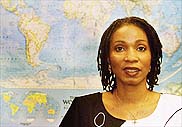














 
|
 Who Is She? Who Is She?
Helene Gayle, M.D., M.P.H.
Director, HIV/AIDS & TB -- Bill & Melinda Gates
Foundation
Dr. Helene Gayle directs the foundation's
HIV/AIDS and Tuberculosis program. Since 1995, she has served as
director of the Centers for Disease Control and Prevention's
(CDC) National Center for HIV, STD, and TB Prevention. She works
with the foundation on detail from CDC.
In her six years as director of the primary CDC center
addressing HIV/AIDS as well as other sexually transmitted
diseases and tuberculosis prevention, Gayle expanded
community-based HIV-prevention activities, particularly for
minority and underserved communities. She helped launch a new
global HIV/AIDS initiative, supported acceleration of syphilis
elimination efforts and expanded efforts for tuberculosis
elimination. At CDC she oversaw a multi-disciplinary staff of
more than 1,400 employees and a budget of approximately $1
billion.
Gayle received her B.A. from Barnard College of Columbia
University, her M.D. from the University of Pennsylvania, and
M.P.H. from Johns Hopkins University.
 A
Charge to Take AIDS Messages From a National to a Global Scale A
Charge to Take AIDS Messages From a National to a Global Scale
By LINDA VILLAROSA
NEW YORK TIMES AUG 28, 2001
When Dr. Helene Gayle began her career at the
Centers for Disease Control in Atlanta in 1984, there was no
AIDS division or office devoted to preventing the disease. No
one knew for sure how it was caused or transmitted or even what
to call it, much less how to stop it.
But 14 years into the epidemic, when the National Center for
H.I.V., S.T.D. and TB Prevention was belatedly created, Dr.
Gayle was chosen to run it. Today the office has a staff of
1,400 and an annual budget of $1 billion.
Now, after 17 years at the C.D.C. and six years of running its
prevention center, Dr. Gayle, 46, is stepping down at the end of
this week to join the Bill and Melinda Gates Foundation as its
senior adviser for H.I.V. and AIDS issues. The foundation, the
world's largest, has earmarked $300 million to fight H.I.V. and
AIDS globally.
During Dr. Gayle's tenure at the agency, the AIDS epidemic has
gone through drastic shifts, and the methods, and messages, of
prevention have evolved. What once seemed an inevitable death
sentence may now be, at least for some, a long-term manageable
disease.
And new trends are emerging as evidence points to a resurgence
of H.I.V. cases among gay men, the group that had been a
prevention success story.
From an office filled with partly packed boxes that will follow
her to a new home in Seattle, Dr. Gayle talked about what she
had learned about preventing AIDS in a constantly changing
landscape, why new cases of the virus continue to appear and
what needs to be done to stop the epidemic.
Q. How has the AIDS prevention message changed since the early
days?
A. At the beginning, once we figured out what we were dealing
with, we focused on doing a general prevention campaign. We
tried to get as much information to as many people as possible.
And to some extent it worked because nearly every adult can tell
you what AIDS is and how it is spread.
Q. Maybe this is too simplistic, but if people know how H.I.V.
is spread and they know it is an incurable disease that will
make you ill if not kill you, why do we still have 40,000 new
cases every year?
A. The notion that prevention is just about knowledge has been
proved wrong again and again. To prevent transmission of the
disease, you have to provide more than just information. The
facts alone rarely change behavior, and when behavioral change
occurs, it happens slowly. Remember that it took decades for
people to change their smoking behavior even though there was
substantial evidence smoking was deadly.
Q. Can you really compare risks that cause lung cancer with
those that cause AIDS? A person may get lung cancer after
smoking for years and years, but with H.I.V. you can get
infected right away, after one instance of unprotected sex with
someone who is infected.
A. People also have a lot of misinformation. Even though just
about everybody knows about AIDS and how it is spread, they may
think they are not at risk because they are not in some specific
category, or they may be denying the risk. For instance, someone
may think, "Yes, I sleep with men, which is risky behavior, but
I only sleep with men who are married, and they are clean."
There is a whole category of people who don't think they are at
risk for one reason or another, and we don't understand this
well. We need a lot more research.
Q. The Bush administration is promoting programs that teach
abstinence rather than sex education. What should we expect as a
result of that?
A. It's safe to say that when it comes to H.I.V. and other
sexually transmitted diseases, you will always be dealing with
issues like sex and drugs. We have been faced with controversial
issues from the beginning of the epidemic, and that hasn't
changed whether there is a Democratic or a Republican
administration.
Q. Can you discuss the report released last month by the
National Institutes of Health that questioned the effectiveness
of condoms? Is that something the current administration
requested?
A. That report was summarized from a meeting that was convened
over a year ago, during the Clinton administration. There was a
lot of confusion around the report; it was not at all well
understood; and it was interpreted from a variety of different
vantage points, depending on what people wanted it to say.
But if you read the report closely, it gives clear evidence and
support that condoms are effective against H.I.V. and some
S.T.D.'s. The available evidence is that condoms protect better
against some S.T.D.'s, like H.I.V., than others.
Q. Studies show an increase in high-risk sexual behavior among
gay men and a rise in H.I.V. infection rates among young gay
men. What is that telling you?
A. First, it says that yesterday's successes can be erased by
today's complacency. We now know that we need to focus much
greater prevention efforts on people who are already infected.
Because of HAART [highly active antiretroviral therapy], people
living with H.I.V. are living longer and are still sexually
active.
In the past, we didn't target those who were positive because we
didn't want to further stigmatize them. So traditionally, care
has been for people who were infected, prevention for those who
weren't. The message was "if you're negative, stay negative."
While we must continue programs for those who are negative, we
also need to reinforce the message that "if you're positive,
don't pass the virus on." We need to help people maintain safe
behavior for the rest of their lives.
Even as we focus on the resurgence among gay men, we can't
forget that there are many gay men who have changed their
behaviors, kids who are saying no to sex, perinatal AIDS
incidence has reached an all-time low, and many drug users have
stopped using or stopped sharing needles.
Q. African-American men who have sex with men have
disproportionately high rates of H.I.V. But a C.D.C. study shows
that they are no more likely to engage in risky sexual behavior
than men of other races. What explains that discrepancy?
A. One hypothesis is that there may be a higher prevalence of
H.I.V. among the sexual partners of these men. We need more
research to confirm that idea, but if young men who have sex
with men are likely to choose their partners from their own
racial or ethnic group and there are a large number of people
infected with H.I.V. in African- American communities — no
matter how they got infected — then high-risk behavior carries a
much greater chance of infection.
Q. What makes a prevention program effective?
A. What works best are programs that are tailored to the needs
of a given population and that work at the community level. If
you know and understand a community, you can get at the
underlying causes of the spread of the virus. For instance,
there are populations of people in which self-esteem affects
their ability to say no or to use condoms.
If you are dealing with a young African- American man who is
confused about his sexuality, feeling stigmatized from his
community and having to grapple with self-hate, telling him to
use a condom or abstain isn't going to work. Or a teenage girl
may feel unempowered, lonely and have low self- esteem, so she
isn't going to be able to say no or get her partner to use
condoms, either.
It's important to handle the root cause, the low self-esteem,
before you try to change the behavior.
Q. In your new job, most of your work will be international. How
will that be different from the work you have done domestically?
A. Though cultures and societies are different, working with
commercial sex workers in Thailand is not dissimilar to working
with populations of gay men here. Around the world the epidemic
affects people who are the most vulnerable because they have
been stigmatized, isolated and marginalized by their society. So
many of the challenges are the same.
Source:
http://www.gatesfoundation.org/aboutus/leadershipstaff/bio_gh_gayle.htm
http://www.uhmc.sunysb.edu/internalmed/hematol/jj/mcs/aids_gates.html
|
|

|
The Fight against AIDS and Tuberculosis
Hear foundation leadership discuss World AIDS Day and HIV/AIDS
awareness and prevention.
(Click questions below to watch streaming video.)

Dr. Helene Gayle, director, HIV/AIDS & TB program
Are HIV/AIDS-prevention strategies effective?
Why participate in World AIDS Day?
The Queen of
Prevention
by John Price
(BlackAIDS.org)
|
|

|